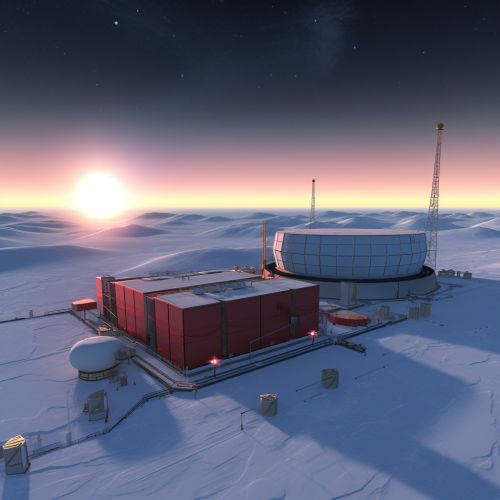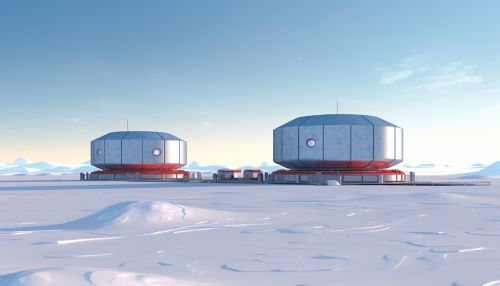IceCube Neutrino Observatory
Overview
The IceCube Neutrino Observatory is a particle detector that operates at the Amundsen-Scott South Pole Station in Antarctica. This observatory is designed to observe the universe from deep within the South Pole ice, detecting cosmic rays and neutrinos, elusive subatomic particles that are extremely difficult to detect. The observatory was completed in December 2010, making it one of the most significant achievements in the field of particle physics in the 21st century.


Design and Construction
The IceCube Neutrino Observatory is a cubic kilometer of ice instrumented with 5,160 digital optical modules (DOMs) that are suspended along 86 strings, each 1.5 kilometers long. These strings are buried deep within the ice at depths ranging from 1,450 to 2,450 meters. The DOMs are designed to detect the faint flashes of blue light, known as Cherenkov radiation, produced when neutrinos interact with the ice.
The construction of the IceCube Neutrino Observatory was a massive international effort. The project began in 2005 and was completed in 2010. The construction process involved drilling deep into the Antarctic ice using a hot water drill and then lowering the strings of DOMs into the holes. The entire process was carried out in the harsh conditions of the Antarctic environment, making it a significant achievement in the field of engineering.
Operation and Research
The primary goal of the IceCube Neutrino Observatory is to detect and study high-energy neutrinos from astrophysical sources. Neutrinos are nearly massless, neutral particles that rarely interact with matter, making them extremely difficult to detect. However, when a high-energy neutrino does interact with a particle of matter, it can produce a charged particle that emits Cherenkov radiation as it travels through the ice. This radiation is detected by the DOMs, allowing the neutrino's direction and energy to be determined.
The IceCube Neutrino Observatory has made several significant discoveries in the field of neutrino astronomy. In 2013, it detected the first high-energy astrophysical neutrinos, opening a new window onto the universe. In 2018, IceCube traced a neutrino back to its source for the first time, identifying a distant blazar as the source of a high-energy neutrino.
Impact and Future Prospects
The IceCube Neutrino Observatory has had a significant impact on the field of particle physics and astronomy. It has opened a new window onto the universe, allowing scientists to study astrophysical phenomena from a new perspective. The observatory's discoveries have also provided new insights into the nature of neutrinos and their role in the universe.
The future prospects for the IceCube Neutrino Observatory are exciting. Plans are underway for an upgrade to the observatory, known as IceCube-Gen2, which will significantly increase its size and sensitivity. This will allow it to detect even more high-energy neutrinos and make even more significant contributions to our understanding of the universe.
